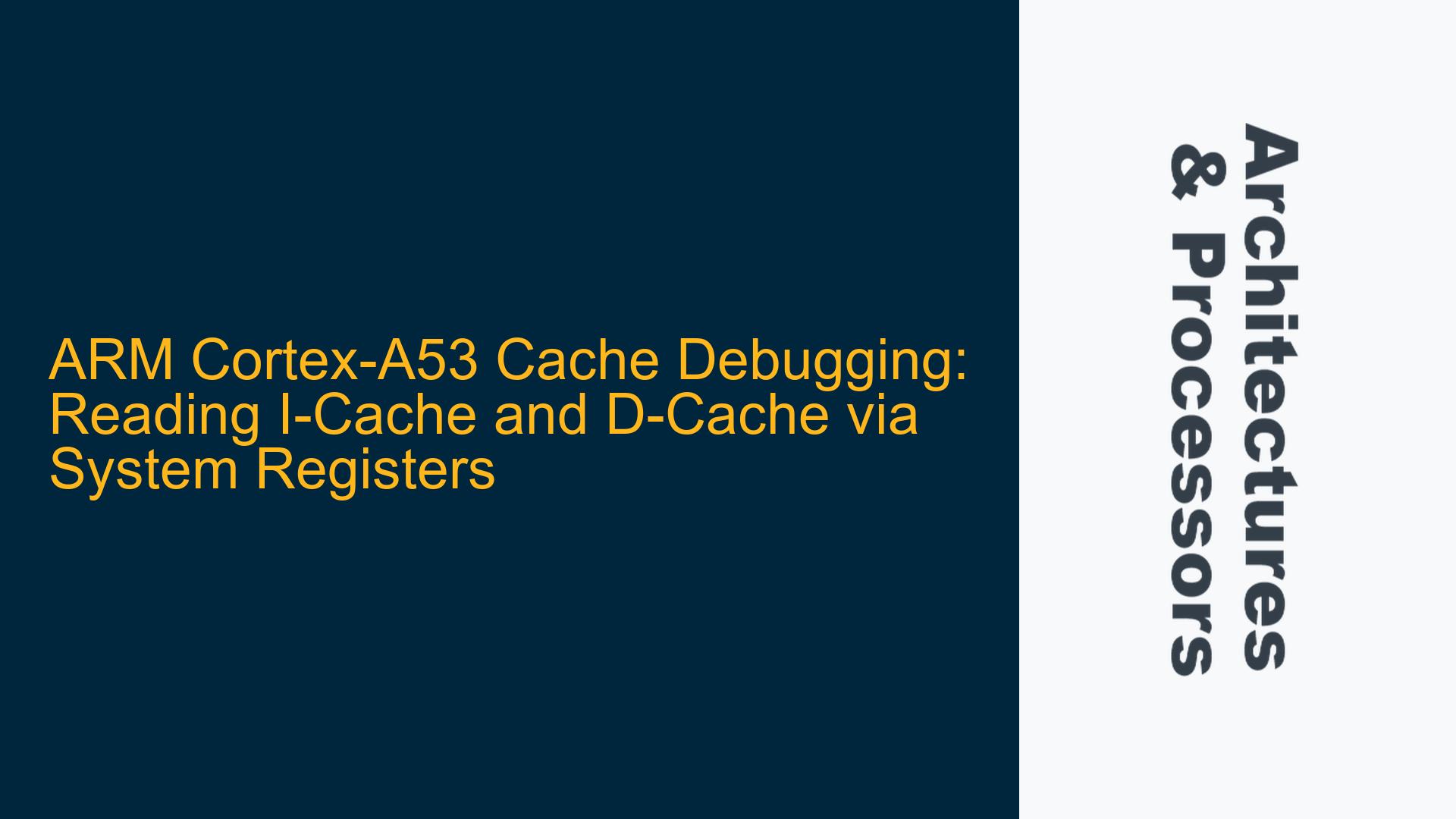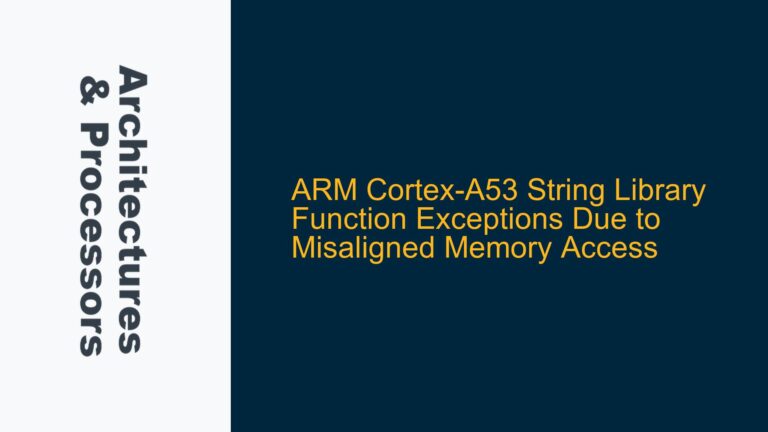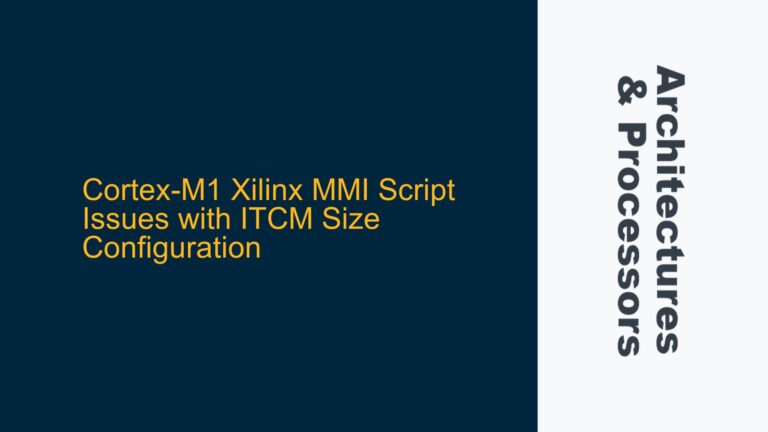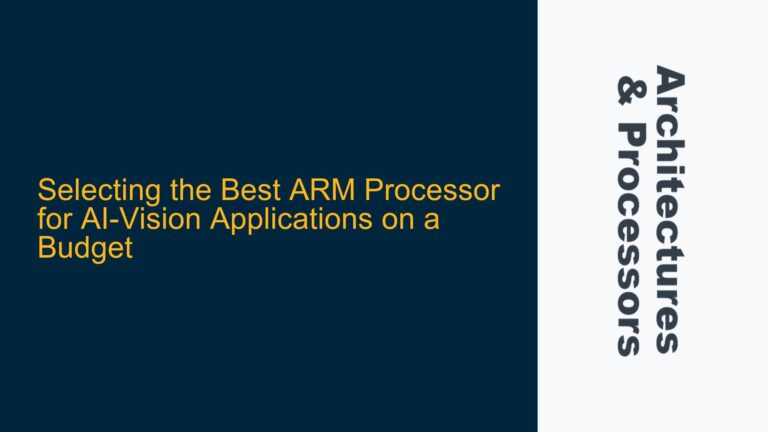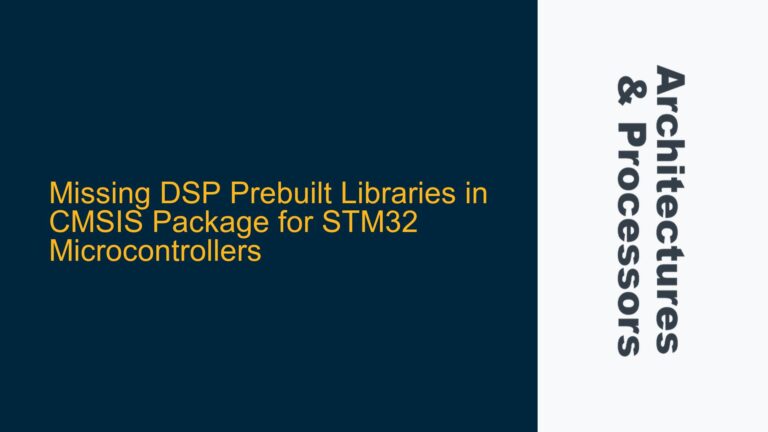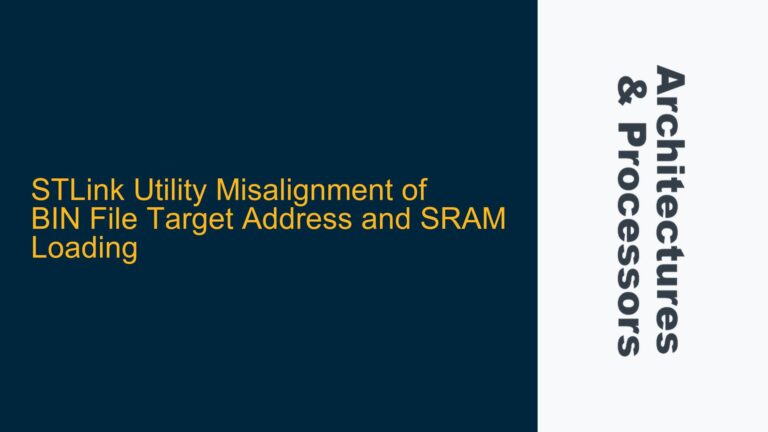ARM Cortex-A53 Cache Debugging Mechanism Overview
The ARM Cortex-A53 processor provides a sophisticated mechanism for debugging and analyzing its internal cache structures, including the Instruction Cache (I-Cache) and Data Cache (D-Cache). This mechanism is facilitated through a set of Implementation-Defined system registers, which allow direct access to the internal memory used by the cache and Translation Lookaside Buffer (TLB) structures. These registers, such as CDBGDR0, CDBGDR1, CDBGDR2, CDBGDR3, CDBGDCT, CDBGICT, CDBGDCD, CDBGICD, and CDBGTD, are specifically designed to enable software to read the contents of the cache and TLB.
The primary objective of this mechanism is to provide developers with the ability to inspect the state of the cache during runtime, which is crucial for debugging complex issues related to cache coherency, performance optimization, and system behavior under various workloads. The Cortex-A53 Technical Reference Manual (TRM) outlines the functionality of these registers, but the implementation details can vary depending on the specific configuration of the processor.
The process of reading the cache contents involves accessing these system registers, which are mapped to specific coprocessor registers. The CDBGDRx registers are used to read the cache data, while the CDBGDCT and CDBGICT registers are used to read the cache tags. The CDBGDCD and CDBGICD registers are used to read the cache data for the data and instruction caches, respectively. The CDBGTD register is used to read the TLB data.
However, reading the cache contents is not as straightforward as simply accessing these registers. The cache is a highly dynamic structure that is constantly being updated as the processor executes instructions and accesses memory. Therefore, to accurately read the cache contents, it is necessary to ensure that the cache state is stable and not being modified during the read operation. This requires careful management of the cache state, including potentially locking the cache to prevent further caching operations while the read is being performed.
Potential Challenges in Reading Cortex-A53 Cache Contents
One of the primary challenges in reading the cache contents of the ARM Cortex-A53 processor is ensuring that the cache state remains consistent during the read operation. The cache is a highly dynamic structure that is continuously updated as the processor executes instructions and accesses memory. This dynamic nature of the cache can lead to inconsistencies if the cache state is not properly managed during the read operation.
Another challenge is the complexity of the cache debugging mechanism itself. The Cortex-A53 processor provides a set of Implementation-Defined system registers for accessing the cache contents, but the exact behavior of these registers can vary depending on the specific configuration of the processor. This variability can make it difficult to develop a generic solution for reading the cache contents that works across different implementations of the Cortex-A53 processor.
Additionally, the process of reading the cache contents involves accessing coprocessor registers, which requires privileged access. This means that the software performing the cache read operation must be running in a privileged mode, such as the kernel mode of an operating system. This requirement can complicate the development of cache debugging tools, as they must be integrated into the operating system or run as part of a privileged software component.
Furthermore, the cache debugging mechanism does not provide a straightforward way to lock the cache state during the read operation. Locking the cache is necessary to ensure that the cache contents remain consistent while they are being read. Without a mechanism to lock the cache, there is a risk that the cache contents could change during the read operation, leading to inconsistent or incorrect results.
Finally, the Cortex-A53 processor supports multiple levels of cache, including L1 and L2 caches. Each level of cache has its own set of debugging registers, and the process of reading the cache contents must be repeated for each level of cache. This adds to the complexity of the cache debugging process, as the software must manage multiple sets of registers and ensure that the cache state is consistent across all levels of cache.
Detailed Steps for Reading and Locking Cortex-A53 Cache Contents
To read the contents of the ARM Cortex-A53 I-Cache and D-Cache, a systematic approach must be followed to ensure that the cache state remains consistent during the read operation. The following steps outline the process of reading the cache contents using the Implementation-Defined system registers, as well as the steps required to lock the cache state to prevent further caching operations during the read.
Step 1: Accessing the Cache Debug Registers
The first step in reading the cache contents is to access the cache debug registers. These registers are mapped to specific coprocessor registers and can be accessed using the MCR and MRC instructions. The CDBGDRx registers (CDBGDR0, CDBGDR1, CDBGDR2, CDBGDR3) are used to read the cache data, while the CDBGDCT and CDBGICT registers are used to read the cache tags. The CDBGDCD and CDBGICD registers are used to read the cache data for the data and instruction caches, respectively. The CDBGTD register is used to read the TLB data.
To access these registers, the software must be running in a privileged mode, such as the kernel mode of an operating system. The following code snippet demonstrates how to access the CDBGDR0 register:
MRC p15, 0, <Rt>, c0, c0, 0 ; Read CDBGDR0 into Rt
In this example, <Rt> is the destination register where the contents of CDBGDR0 will be stored. Similar instructions can be used to access the other cache debug registers.
Step 2: Locking the Cache State
To ensure that the cache contents remain consistent during the read operation, it is necessary to lock the cache state. Locking the cache prevents further caching operations from modifying the cache contents while the read is being performed. Unfortunately, the Cortex-A53 processor does not provide a direct mechanism for locking the cache. However, it is possible to achieve a similar effect by disabling the cache temporarily.
The cache can be disabled by clearing the appropriate bits in the System Control Register (SCTLR). The following code snippet demonstrates how to disable the I-Cache and D-Cache:
MRC p15, 0, <Rt>, c1, c0, 0 ; Read SCTLR into Rt
BIC <Rt>, <Rt>, #(1 << 2) ; Disable D-Cache
BIC <Rt>, <Rt>, #(1 << 12) ; Disable I-Cache
MCR p15, 0, <Rt>, c1, c0, 0 ; Write modified SCTLR back
In this example, <Rt> is the register used to hold the value of the SCTLR. The BIC instructions are used to clear the bits that control the I-Cache and D-Cache, effectively disabling them. Once the cache is disabled, the cache contents will remain stable, allowing the software to read them without the risk of modification.
Step 3: Reading the Cache Contents
With the cache state locked, the next step is to read the cache contents using the cache debug registers. The process of reading the cache contents involves iterating through the cache lines and reading the data and tags for each line. The following code snippet demonstrates how to read the contents of the D-Cache using the CDBGDCT and CDBGDCD registers:
; Set up the cache line index
MOV <Rt>, #0 ; Initialize the cache line index
read_cache_line:
; Read the cache tag
MRC p15, 0, <Rt1>, c2, c0, 0 ; Read CDBGDCT into Rt1
; Read the cache data
MRC p15, 0, <Rt2>, c4, c0, 0 ; Read CDBGDCD into Rt2
; Process the cache line data and tag
; (e.g., store the data and tag in memory for later analysis)
; Increment the cache line index
ADD <Rt>, <Rt>, #1
; Check if all cache lines have been read
CMP <Rt>, #<num_cache_lines>
BLT read_cache_line
In this example, <Rt> is used to hold the cache line index, <Rt1> is used to hold the cache tag, and <Rt2> is used to hold the cache data. The MRC instructions are used to read the cache tag and data for each cache line. The ADD instruction is used to increment the cache line index, and the CMP and BLT instructions are used to check if all cache lines have been read.
Step 4: Re-enabling the Cache
Once the cache contents have been read, the final step is to re-enable the cache. This is done by setting the appropriate bits in the SCTLR. The following code snippet demonstrates how to re-enable the I-Cache and D-Cache:
MRC p15, 0, <Rt>, c1, c0, 0 ; Read SCTLR into Rt
ORR <Rt>, <Rt>, #(1 << 2) ; Enable D-Cache
ORR <Rt>, <Rt>, #(1 << 12) ; Enable I-Cache
MCR p15, 0, <Rt>, c1, c0, 0 ; Write modified SCTLR back
In this example, <Rt> is the register used to hold the value of the SCTLR. The ORR instructions are used to set the bits that control the I-Cache and D-Cache, effectively re-enabling them. Once the cache is re-enabled, the processor will resume normal caching operations.
Step 5: Handling Multiple Cache Levels
The Cortex-A53 processor supports multiple levels of cache, including L1 and L2 caches. The process of reading the cache contents must be repeated for each level of cache. Each level of cache has its own set of debugging registers, and the software must manage multiple sets of registers and ensure that the cache state is consistent across all levels of cache.
For example, to read the contents of the L2 cache, the software must use the appropriate cache debug registers for the L2 cache. The process of reading the L2 cache contents is similar to that of the L1 cache, but the specific registers and cache line indices may differ. The following table summarizes the cache debug registers for the L1 and L2 caches:
| Cache Level | Tag Register | Data Register |
|---|---|---|
| L1 D-Cache | CDBGDCT | CDBGDCD |
| L1 I-Cache | CDBGICT | CDBGICD |
| L2 Cache | L2CDBGDCT | L2CDBGDCD |
In this table, L2CDBGDCT and L2CDBGDCD are hypothetical registers for the L2 cache. The actual register names may vary depending on the specific implementation of the Cortex-A53 processor.
Step 6: Verifying the Cache Contents
After reading the cache contents, it is important to verify that the data is accurate and consistent. This can be done by comparing the cache contents with the expected values based on the program’s execution. Any discrepancies between the cache contents and the expected values may indicate issues with cache coherency, memory consistency, or other system-level problems.
To verify the cache contents, the software can compare the cache data and tags with the expected values stored in memory. The following code snippet demonstrates how to verify the contents of the D-Cache:
; Assume that the expected cache data and tags are stored in memory
LDR <Rt1>, [<expected_data_addr>] ; Load expected data
LDR <Rt2>, [<expected_tag_addr>] ; Load expected tag
; Compare the expected data and tag with the actual cache data and tag
CMP <Rt1>, <Rt2> ; Compare expected data with actual data
BNE data_mismatch ; Branch if data mismatch
CMP <Rt2>, <Rt3> ; Compare expected tag with actual tag
BNE tag_mismatch ; Branch if tag mismatch
; If no mismatches, the cache contents are correct
B cache_verification_complete
data_mismatch:
; Handle data mismatch (e.g., log the error, halt the system)
tag_mismatch:
; Handle tag mismatch (e.g., log the error, halt the system)
cache_verification_complete:
; Continue with normal execution
In this example, <Rt1> and <Rt2> are used to hold the expected cache data and tag, respectively. The CMP instructions are used to compare the expected values with the actual cache data and tag. If a mismatch is detected, the software can handle the error appropriately, such as by logging the error or halting the system.
Conclusion
Reading the contents of the ARM Cortex-A53 I-Cache and D-Cache is a complex process that requires careful management of the cache state and precise access to the cache debug registers. By following the steps outlined in this guide, developers can successfully read and verify the cache contents, enabling them to debug complex issues related to cache coherency, performance optimization, and system behavior. However, it is important to note that the exact implementation details may vary depending on the specific configuration of the Cortex-A53 processor, and developers should refer to the processor’s Technical Reference Manual for the most accurate and up-to-date information.
